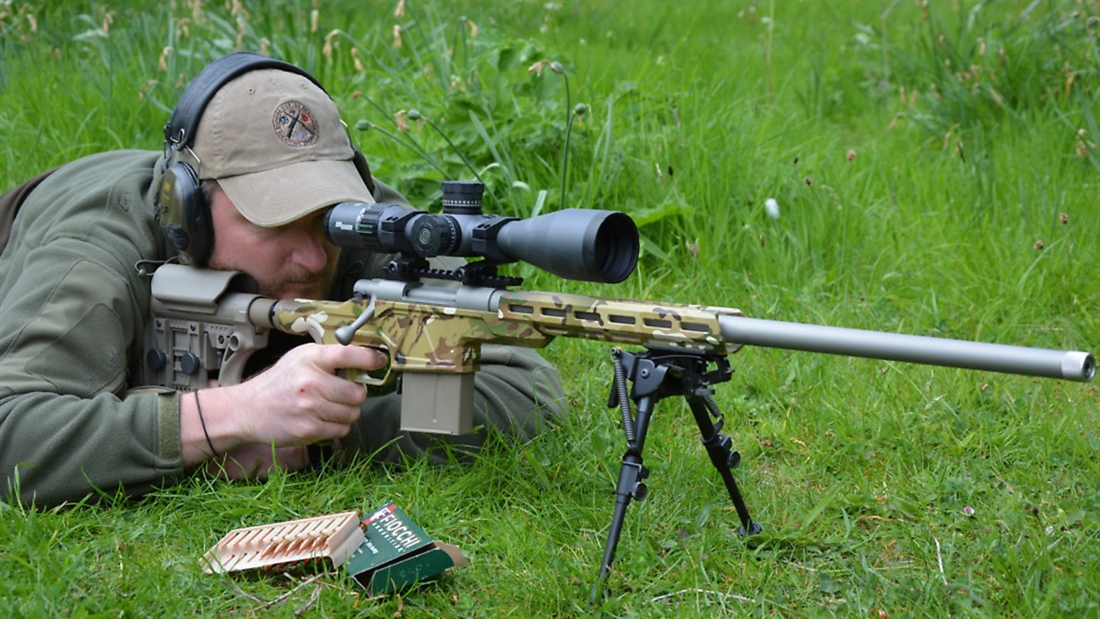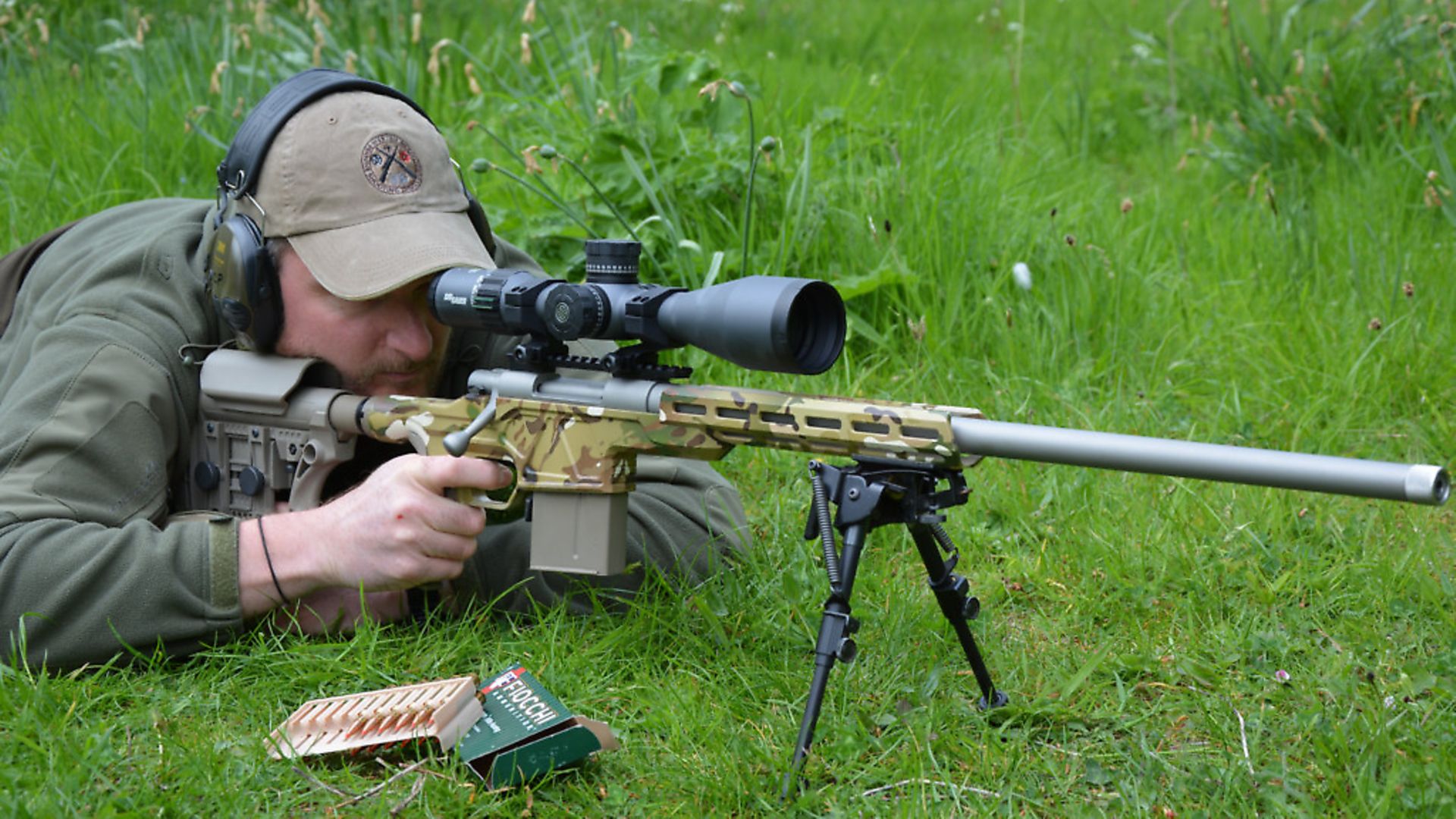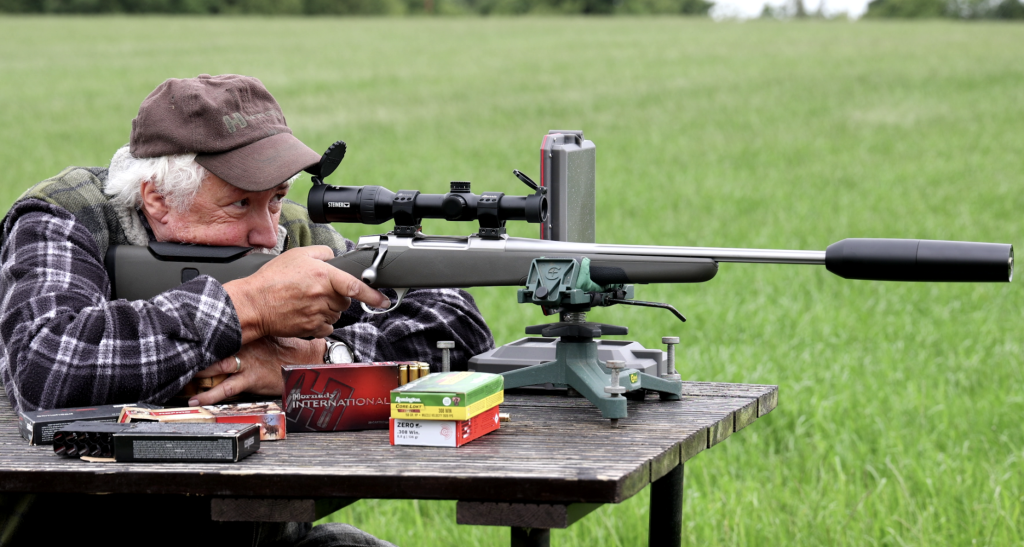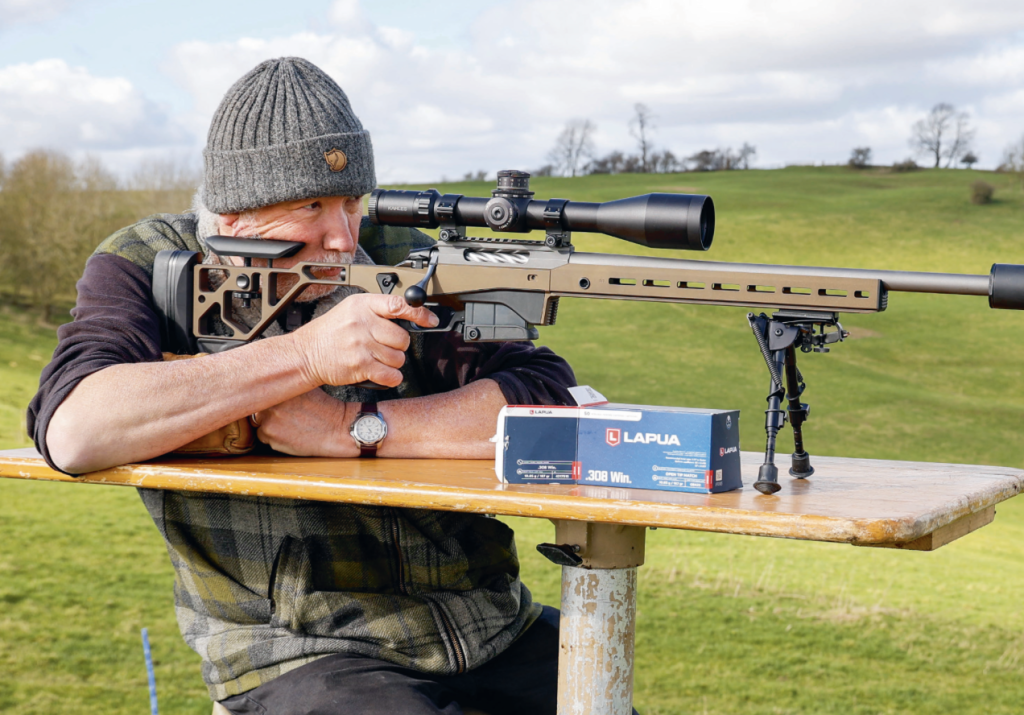Howa Chassis Rifle (HCR) in .308 Winchester – test and review

Offering fabulous value for money, the Howa Chassis Rifle (HCR) in .308 Winchester gets off to a good start in this test with Chris Parkin… but how does it shoot?
PROS
An inherently good barrelled action with good accuracy on factory loads
Will benefit further from handloading
Entry level plain blue rifle package brings excellent value for money in the chassis rifle market
Excellent trigger and build quality
CONS
Cheekpiece on the stock is too bulky in my opinion
The serrated buttplate ruins the rifle’s otherwise stable recoil characteristics by biting into your shoulder
VERDICT
Minimal modifications to the stock design will allow this rifle to shine far brighter. The action and stock deserve better recoil control as they are fundamentally accurate, and the 610mm barrel gives a few extra critical feet per second and factory ammunition accuracy than the 510mm competition. That recoil pad is a deal breaker, in my opinion and that of all those who shot it
TECH SPECS
Barrel: Cerakote Stainless Heavy barrel, 21.6mm muzzle diameter
Barrel length: 610mm/24”
Overall length: 1130mm/44 ½”
Weight: 4.92kg/10.84lbs
Muzzle thread: 5/8”
Stock: Aluminium Chassis with AR15 Compatible grip and butt
Length of pull: 340-417mm-13 1/8- 16 1/2” +23mm reoil pad adjust
Trigger: 2 stage HACT breaking at
Safety: 3 stage with bolt lock
Magazine: AICS compatible 10 round detachable
RRPs
GUN + ACCESSORIES
Howa Action, with Cerakote Varmint Barrel – SRP £830.99
Howa HCR Chassis, Multi Cam – SRP £878.99
Accurate Mag, 10rd 308, FDE finish – SRP £127.99 (plain black is £111.99)
EGW 20 MOA, Howa S/A rail – SRP £67.99
Sig Sauer 34mm ALPHA Rings – SRP £114.99
Sig Sauer Tango 6, 5-30×56 MOA LevelPlex – SRP £2526.99
PACKAGE DEALS
HCR Chassis rifle combo with Cerakoted barrelled action, Accurate mag, a choice of either a Nikko Stirling or Sig Scope, Choice of moderators (Aimport or Sonic) and a hard case is £1989.99
Blued rifle with chassis and mag only for £1549.97.
Contact: Highland Outdoors
01858 880 491 www.highlandoutdoors.co.uk
AMMO
Lapua 150gr Soft Point ammunition
www.vikingarms.com 01423 780810
Fiocchi 150gr SST ammunition
www.edgarbrothers.com 01625 613177
Winchester 150gr Extreme Point ammunition
www.browning.eu 01235 514550
IN DEPTH ANALYSIS
I‘ve liked the Howa approach to rifle specification options for some time, with sporter- and varmint-barrelled actions made available along with a wide range of stock designs. A good functional action and barrel can be totally characterised by the furniture they sit in, so Howa has made the obvious step of introducing a chassis stock option to follow current market trends.
Howa’s ‘HCR’ stock is a chassis system with an AR15 compatible pistol grip and a butt stock by Luth-AR mounted to the six-position extending buffer tube, with an open ‘U’ channel fore-end, which fully floats the barrel in all conditions. A multicam-dipped, fully CNC-machined aluminium chassis with Flat Dark Earth polymer butt matches the similarly FDE Cerakoted Accurate mag, holding 10 rounds of .308 ammunition. A slightly staggered column centre feeds into the chassis’ incorporated mag well; this is an identical version of the Accuracy International AICS mag that is so popular across the board, and works in a similar way. The follower could do with a chamfer on its rear edge, as it did snag the rim on the last round a few times in its early use, before it was worn in by the rounds themselves.
Howa’s HACT triggers keep getting better, and this two-stage unit broke nicely at just 975g. The right-side safety has three positions and locks the bolt in its rearward-most spot. This unit is a huge step forwards for Howa – it is now consistent to shoot without any creep on the slender, black, ribbed blade or ‘notchiness’ in the safety, which engages cleanly and quietly under your thumb at the rear of the action. Ninety-degree bolt lift does leave the handle of the twin-lugged push-feed action very close to the scope, but the Sig Arms optic fitted has a very large 46mm ocular body and will never be a subtle addition to any rifle (the magnification collar has a lot of sharp details and corners on it, so wasn’t pleasant to brush up against). An A2-styled grip sits below the action with expected short reach to the trigger, but this is a fact of life on AR derivative builds. The Luth-AR butt stock, with its buffer tube screwed into the rear of the chassis, was not the nicest option for two reasons.
Firstly, the cheekpiece is characteristically very chunky, in order to envelop the buffer tube, so you need high scope mounts to keep the eyeline for the optic above it. Its triangular cross section, with a 59mm width at the base, makes your head roll over the top of it to get cheek weld and exit pupil alignment with correct eye relief. Your own jawbone places your head much too far off to one side, and being Plain FDE polymer build, it rattles clumsily when knocked.
The second reason is the butt plate. Yes, it’s a solid plastic plate. It will adjust laterally by 25mm but only downwards from centre, which is a nod towards its high-power shooting origins; but worst is that the serrated edge of the plate bites into your shoulder with every shot. I regularly shoot hundreds of rounds of .308 in a day and rarely bother about it, but 50 rounds in one session was quite enough on the HCR before I was bruising up. A firm rubber butt pad would cure all this and transform the rifle, as the barrelled action performed extremely well.
I fired a selection of the usual ammunition suspects through the rifle, which showed no great preference from its 610mm barrel with a 1 in 12” (300mm) twist rate. All quality ammunition was capable of 25-30mm five-round groups at 100m, with, yet again, a slight nod to the Fiocchi 150gr SST ammunition for producing the most sub 20mm groups with a velocity of 863m/s or 835fps. I would love to have hand-loaded for this rifle as I liked the trigger, and it positioned and aimed well in the prone position, but the aforementioned recoil character dulled my enthusiasm. AR15 parts are designed around the low recoil of a .223 semi-auto rifle and, when modified, multi-positional shooting. To me, though, the whole point of going down this route is pointless if you compromise on ergonomics, shooter comfort and consequent control. In its ultimate tube gun format, the line of recoil force is directed centrally into the shoulder by keeping the barrel low with respect to the butt pad, minimising muzzle flip. I liked the HCR, but I believe a rethink on the butt stock would be worthwhile for a calibre larger than .223. The Sig Sauer optic, supplied with a 20 MOA scope rail and Sig’s own rings, was an ideal specification to make the most of the rifle’s capability; precise aim was made possible by the 5-30x magnification range with its reticle in the first focal plane and, thankfully, MOA clicks and matching reticle subtensions within for equal opportunities to aim off or dial off when target shooting. It would also make a great scope for long-range varminting in daylight conditions, but it is quite bulky and heavy. The reach-forward design of the rings can be helpful on some guns, but the swooping longitudinal ‘V’ shape robs space in a scope mounting situation, and was clearly designed by a CNC stylist rather than a shooter. Thankfully, the EGW Picatinny rail, bolted in four places to the top of the stainless steel action, was long enough to alleviate any problems. You will also want high scope rings to clear that bolt handle, as well as to free up space and keep your head high in relation to the cheekpiece… unless you particularly like to lay your head on a gun sideways and weld down tight. I don’t.
Feed and ejection on Howas is always reliable, with the magazines soon wearing in to smoothly present all 10 rounds from the feed ramp into the chamber. A single plunger ejector flings brass effortlessly from the gun, after the claw extractor unleashes it from its interference bond with the chamber walls after firing. The bolt release catch is to the left rear of the action, and you don’t need to adjust the cheekpiece to extract it; a pull-down button on the butt allows the gun to extend way back on the telescopic buffer tube. This, in addition to the 25mm extension available directly at the recoil plate, gives one of the longest possible gunstocks I have ever used, with up to 16½” overall length to the trigger blade, from a minimum of 131/8”.
Cerakoting the stainless-barrelled action adds more corrosion resistance, but a black action/stock also keeps the price down for better value in the money game that will see this gun take on the Ruger Precision Rifle (RPR) head to head. The RPR is, to be frank, a more homogenous design, with recoil directed straight into the centre of the pad which is in line with the gun, rather than slung below it to give better ergonomics; the Howa has nicer build quality and a better trigger, though. I also prefer the open ‘U’ channel fore-end of the Howa as it gives more airflow for cooling, reduces bulk, and retains a solid anchoring stud for a Harris bipod, with multiple mounting locations if you want to add a Picatinny rail for an Atlas or the like (if, however, you adopt more standing/kneeling PR techniques, it hasn’t got as much to fill your hand as a tubular fore-end that can totally encompass the barrel).
As a slight paradox, the ‘U’ channel would allow a scope to be mounted closer to the bore, but the action’s stock needs to keep the scope high to perform like a tube gun, regardless of the space needed to operate the bolt without bashing into the scope’s ocular body at speed. The muzzle is threaded for a brake or moderator, but I kept it naked because I like to know what I’m attempting to tame before I add any such accessories.
Mods cut noise and recoil but suffer from mirage; brakes cut even more recoil to lessen muzzle jump, but you get more translated shock waves coming backwards and greater noise presented around you than a bare muzzle… so, I veer away from them these days.
Related Articles
Get the latest news delivered direct to your door
Subscribe to Rifle Shooter
Elevate your shooting experience with a subscription to Rifle Shooter magazine, the UK’s premier publication for dedicated rifle enthusiasts.
Whether you’re a seasoned shot or new to the sport, Rifle Shooter delivers expert insights, in-depth gear reviews and invaluable techniques to enhance your skills. Each bi-monthly issue brings you the latest in deer stalking, foxing, long-range shooting, and international hunting adventures, all crafted by leading experts from Britain and around the world.
By subscribing, you’ll not only save on the retail price but also gain exclusive access to £2 million Public Liability Insurance, covering recreational and professional use of shotguns, rifles, and airguns.
Don’t miss out on the opportunity to join a community of passionate shooters and stay at the forefront of rifle technology and technique.





